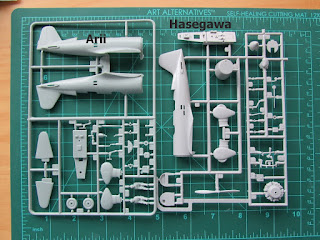Wednesday, December 28, 2016
Wednesday, November 30, 2016
Mitsubishi Ki-15 civil (Arii and Hasegawa kits)
The rare finding of a relatively old kit that still holds up
well -regarding details and accuracy- is a source of joy, especially when its
price is low!
Separated wheels:
The red line bordering the sun rays is incorrect:
Comparison between Arii's and Hasegawa's offerings:
The Mania kit (incarnation of Hasegawa):
Both have somewhat flattened engines, arguably the only parts that would truly benefit from an aftermarket replacement, although I couldn't find one:
Both transparencies are quite decent:
Arii's Mitsubishi Ki-15 is in the same league as the
Mitsubishi G3M that I posted before, both coming from the same origins and
being reboxed now with new decals.
They are Buddhist kits, that is, they went through many
re-incarnations as LS, Arii and possibly other lives.
I am so glad I bought these two, since civilized versions of
machines so far known for bad deeds give me a sense of hope about humanity (and modelers, who present in general a
strong tendency to represent war, destruction and conflict, pushed by market
offerings that mainly perpetuate that tradition, although more and more,
fortunately, we see manufacturers offering refreshing and significant civil
options, with wonderful stories behind, much more appropriate to share with the
little ones that war and destruction).
In the accompanying photos you can see the quality of the
molds, good for an old kit, with barely some minimum flash.
It comes with a set of decals that can stand for two planes,
J-BAAL and J-BAAI, but you don't get two sets, just alternate last letters. The
sun motif is bordered by a red line, which is incorrect. The interior is very
succinct and can be improved if desired adding detail from photos, but if you
do that you may like to create a vac canopy to pose some sections open,
otherwise no interior will be really visible.
There is a Hasegawa version of this plane (also released as Mania), quite good too
(and also old), that is much harder to get (was released as a double kit, with
two planes and two sets of decals to represent Kamikaze (wind spirit) and
Asakaze (morning wind). Since I couldn't get that one, I bought the
"normal" Ki-15 offering just to compare it to the Arii one.
The molds are not the same, although there are very similar in quality and surface treatment. I like better the interior of the Hasegawa kit, which includes more detail, but find the wheel "glued" to the spats (instead of being a separate part) a poor choice. The Hasegawa kit needs one small window blanked out, and there are different solutions for the break-down of some shapes. Otherwise, both kits are very nice. It becomes a matter of the decals for the civil versions. If you can't get the Hasegawa double release with the civil markings (the Arii offering is readily available at a very convenient price), you will have to print or commission your own decals.
The molds are not the same, although there are very similar in quality and surface treatment. I like better the interior of the Hasegawa kit, which includes more detail, but find the wheel "glued" to the spats (instead of being a separate part) a poor choice. The Hasegawa kit needs one small window blanked out, and there are different solutions for the break-down of some shapes. Otherwise, both kits are very nice. It becomes a matter of the decals for the civil versions. If you can't get the Hasegawa double release with the civil markings (the Arii offering is readily available at a very convenient price), you will have to print or commission your own decals.
Bellow are images of both kits.
The contents of Arii's offering. One plane, one set of registrations but additional last letters to change it:
Neat sprues, engraved detail:Separated wheels:
The red line bordering the sun rays is incorrect:
Comparison between Arii's and Hasegawa's offerings:
The Mania kit (incarnation of Hasegawa):
Both have somewhat flattened engines, arguably the only parts that would truly benefit from an aftermarket replacement, although I couldn't find one:
Both transparencies are quite decent:
To be continued......
Tuesday, November 29, 2016
Sopwith Pup 1921 Aerial Derby + Arctic Decals- 1/72
The 1921 Aerial Derby racer is now complete.
The step-by-step construction article is here:
Once again, profuse thanks to friend and fellow modeler
Sönke Schulz who gifted the nice Airfix kit. Thanks also for the article on the issue #5 of The Aviation
Historian magazine, and especially to Mika Jernfors of Arctic Decals. He
produced a remarkable set that made possible this model. The link to his site can be found on the side bar together with the other links.
Regarding the article in the magazine, I did not follow it
entirely on a few details, as I do not 100% coincide on the drawings'
interpretation, comparing them with photos. Some of this was explained in the
step by step construction article.
This was indeed a fun project, starting with an inexpensive
but nice old kit and thanks to those superb decals.
A few modifications are needed as described on the
step-by-step building article, but nothing out of the ordinary. As you can see I added a "posed" Small Stuff resin engine, much better than the one inside
the cowl of the kit (barely visible anyway), as a way to confer a sense of
"ambience" without going into a complicated diorama.
This little model is one more example of what you can do to finish a wartime
plane in a much more colorful, uplifting, peaceful, meaningful, exciting,
out-of-the-ordinary and rewarding decoration.
Subscribe to:
Comments (Atom)

























































































